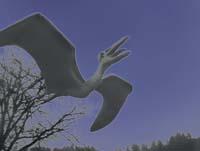How did pterosaurs fly?

Paleontologists from Massachusetts have studied how pterosaurs, flying reptiles that dominated the sky in Mesozoic flew. To fly they have seen that the mobile of the chest box and a system composed of air sacks that helped disperse the air through the bones.
The study of more than 100 fossils of this animal has shown that the chest box expands and contracts. This circulation of air allowed the exchange of carbon dioxide and oxygen necessary to maintain its metabolism. Holes have also been analyzed between the bones of these animals. These deficiencies are related to air sacks, and it is concluded that a greater pterosaurus greater number of air sacks. These gaps facilitate the circulation of oxygen and it is possible that the bones become lighter.





